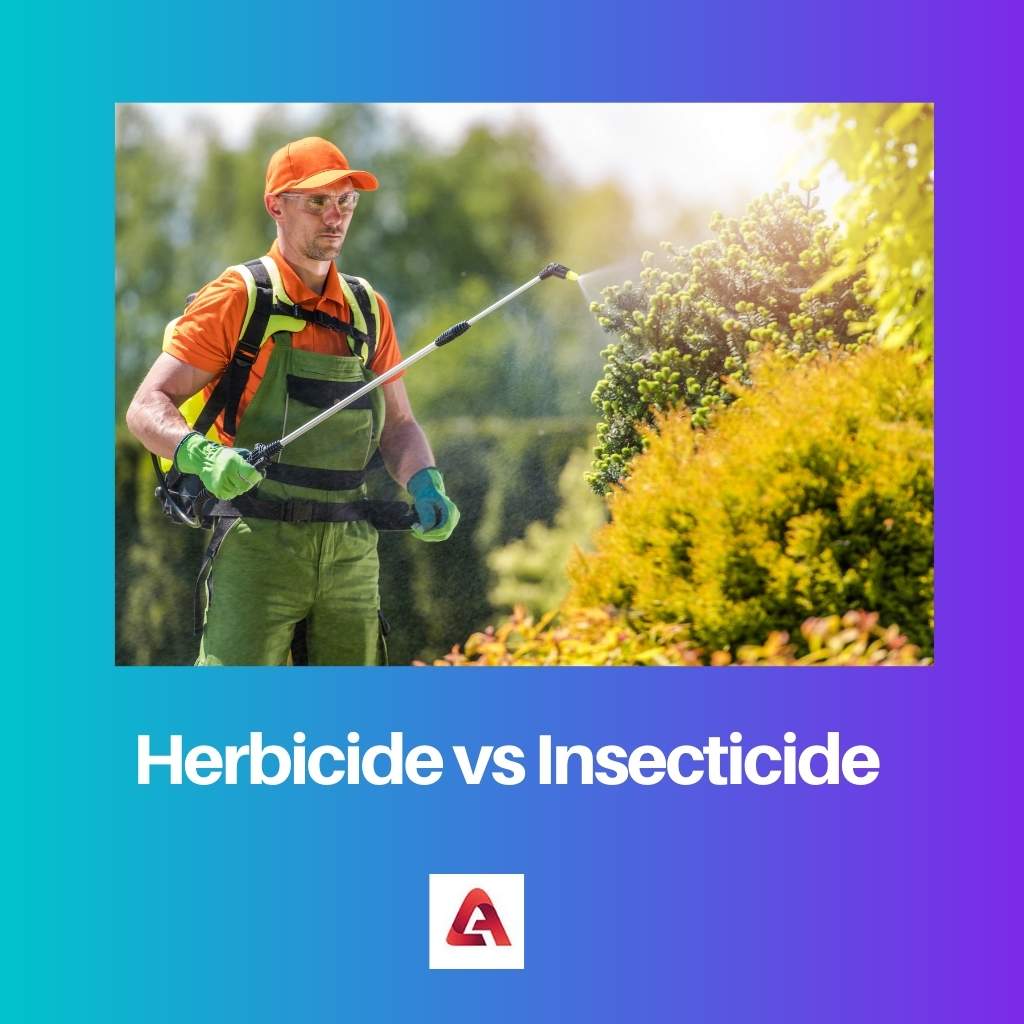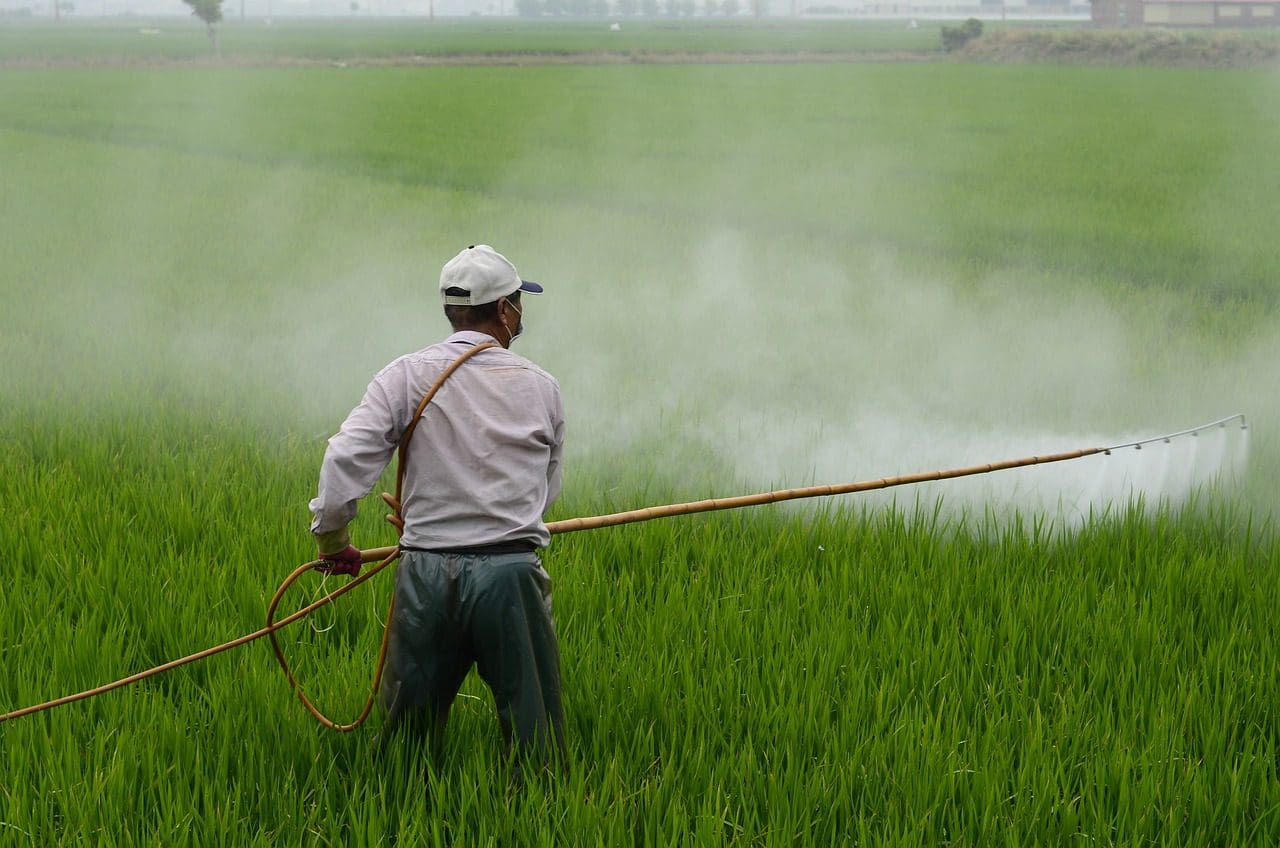Herbicide and Insecticide are two types of Pesticides that are used by farmers in the process of farming to protect their crops and plants from being damaged.
Pesticides are chemical or organic substances used to spray above the cultivated crops and plants on the fields to protect them from various other harmful diseases, insects, organisms, etc.
There are various kinds of Pesticides, and Herbicides and Insecticides are among them. The various Pesticides are used based on the problem that has emerged in the crops and plants.
Other various Pesticides include Fungicides, Rodenticides, Bacteriacides, Avicides, etc.
Key Takeaways
- Herbicides target unwanted plants or weeds, while insecticides eliminate harmful insects and pests.
- Herbicides are available in selective or non-selective forms, whereas insecticides can be contact, systemic, or biological.
- Proper application of herbicides helps maintain crop health, while insecticides protect crops from insect infestations and diseases.
Herbicide vs Insecticide
Herbicide is a toxic substance that is used to control weeds or undesired plants and vegetation, also called a weed killer. It can also damage parts of a plant. Insecticide is a chemical or toxic substance that is used to control insects by stopping them from engaging in destructive behaviours or killing them.

Herbicides are used to kill the unwanted or to stop the unwanted growth of the plants. It is specifically manufactured for the usage of plants.
Herbicides are further subdivided into two types, which include Contact Herbicides and Systemic Herbicides. There are both biodegradable and non-biodegradable Herbicides in the market. It has both advantages and disadvantages.
The Chemical Compositions of Herbicides include things like Chlorinated Hydrocarbons/Organochlorines, Organophosphates, etc. On the other hand, Insecticides are used to kill harmful and dangerous insects for plants and crops.
It is specifically manufactured for the usage of killing insects. Insecticides are further subdivided into three types, which include Contact Herbicides, Ingested Herbicides, and Systemic Herbicides.
Also, there are both biodegradable and non-biodegradable Insecticides in the market. The Chemical Compositions of Insecticides include things like Carbonates, Pyrethroids, Triazineas, etc.
Comparison Table
| Parameters of Comparison | Herbicide | Insecticide |
|---|---|---|
| Definition | Herbicides are substances that protect plants from unwanted weeds and flower beds. | Insecticides are substances that protect plants from harmful insects on plants. |
| Common or another Alternate name | Herbicide is also commonly known as weed killer. | The insecticide is also commonly known as a pest killer. |
| Types | There are two types of Herbicides in the market, and they are Contact Herbicide and Systemic Herbicide. | There are three types of Insecticides in the market and are Systemic Insecticide, Ingested Insecticide, and Contact Insecticide. |
| Main Usage | The main usage of Herbicide is that it removes the unwanted weeds and stops the unwanted growth of the plants. | The main use of Insecticide is that it removes harmful insects from the plants. |
| Advantages | The advantages of Herbicides include things like it kills unwanted plants, it kills weeds and also helps them to grow properly, they are handy and easy to use, it works fast, the organic herbicides are safe for usage, etc. | The advantages of Insecticides include things like they kill the harmful insects that degrade the growth of the plants and crops, it prevents the wastage of foods, it also controls various dangerous insects diseases that are spread through the harmful insects, etc. |
| Disadvantages | The disadvantages of Herbicides include things such as they are toxic for some percentage, they can also cause illness among the organisms that consume them, the herbivore animals might sometimes consume it without prior knowledge, etc. | The disadvantages of Insecticides include things like sometimes the non-targeted insects or animals might be killed, also sometimes the resistance of some insects are so high that they have zero effect on the insecticide and hence, they end up destroying the plants and crops. |
| Chemical Group | Commonly Herbicides include chemical groups such as Chlorinated Hydrocarbons/ Organochlorines, Organophosphates, etc. | Commonly, Insecticides includes chemical group such as Carbonates, Pyrethroids, Triazineas, etc. |
| Some common names of Pesticides that are available in the market | Some commonly used Herbicides are Gycel, Roundup, etc. | Some commonly used Insecticides are Pyrethric, Rogor, Surya Neem, etc. |
What is Herbicide?
The substance that is used to preserve crops and plants from other harmful weeds is known as Herbicides.
Many times, some harmful weeds and flower beds grow near the plants and crops, which decreases the strength of the plants to grow properly, hence, the farmers use Herbicides.
It is both available in the organic and inorganic form, and the inorganic Herbicides are more harmful to the other non-targeted animal that consumes it. Also, Herbicides are commonly known as weed killers.
There are two types of Herbicides in the market they are Contact Herbicide and Systemic Herbicide. Contact Herbicides are the herbicides that are permanently absorbed by the plants.
Systemic Herbicides are Herbicides that can be washed away from the plants or the plant’s leaves.
Commonly, Herbicides include chemical groups such as Chlorinated Hydrocarbons/ Organochlorines, Organophosphates, etc. Herbicides are manufactured with the help of these chemical compositions.
As we know, it is manufactured in both organic and non-organic form, hence it has both advantages and disadvantages.
The advantages of Herbicides include things like killing unwanted plants, killing weeds and helping them to grow properly, they are handy and easy to use, they work fast, the organic herbicides are safe for usage, etc.
Its disadvantages include things such as they are toxic for some percentage, and they can also cause illness among the organisms that consume it, herbivore animals might sometimes consume it without prior knowledge, etc.
There are various brands available in the market to buy Herbicides.

What is Insecticide?
Insecticides are substances that are used to kill various insects that can damage crops and plants by building their houses or by laying eggs.
It is not only used by farmers to protect the plants from insects but also for various other purposes such as in medicine, industries, or also by consumers to kill cockroaches specifically. It is also known as a pest killer.
It is found in both liquid and granular forms. The liquid form is used in agricultural activities, as it is handy to spray upon plants and crops. In contrast, the powdery form is used in the soil.
Insecticides are manufactured in a way that prevents various diseases from being spread by insects. It is divided into three types. They are Systemic Insecticide, Ingested Insecticide, and Contact Insecticide.
Also, some Insecticides are found in the organic form and in the organic form. Commonly, Insecticides includes chemical group such as Carbonates, Pyrethroids, Triazineas, etc.
It is very harmful, too, if some consume or get in contact with the Insecticides while using.
The advantages of Insecticides include things like killing the harmful insects that degrade the growth of plants and crops, preventing the wastage of foods, and controlling various dangerous insect diseases that are spread through the harmful insects, etc.
On the other hand, its disadvantages are that sometimes the non-targeted insects or animals might be killed, and sometimes the resistance of some insects is so high that they have zero effect on the insecticide, and hence, they end up destroying the plants and crops.

Main Differences Between Herbicides and Insecticides
- Herbicides are substances that protect plants from unwanted weeds and flower beds. On the other hand, Insecticides are substances that protect the plants from harmful insects on the plants.
- Herbicide is also commonly known as weed killer. On the other hand, Insecticide is also commonly known as pest killer.
- There are two types of Herbicides in the market they are Contact Herbicide and Systemic Herbicide. On the other hand, there are three types of Insecticides in the market: Systemic Insecticide, Ingested Insecticide, and Contact Insecticide.
- The main usage of Herbicide is that it removes the unwanted weeds and stops the unwanted growth of the plants. On the other hand, the main use of Insecticide is that it removes harmful insects from the plants.
- The advantages of Herbicides include things like killing unwanted plants, and weeds and also helping them to grow properly, they are handy and easy to use, they work fast, the organic herbicides are safe for usage, etc. On the other hand, the advantages of Insecticides include things like killing the harmful insects that degrade the growth of plants and crops, preventing the wastage of food, and controlling various dangerous insect diseases that are spread through the harmful insects, etc.
- The disadvantages of Herbicides include things such as they are toxic for some percentage, they can also cause illness among the organisms that consume them, the herbivore animals might sometimes consume them without prior knowledge, etc. On the other hand, the disadvantages of Insecticides include things like sometimes the non-targeted insects or animals might be killed, also sometimes the resistance of some insects are so high that they have zero effect on the insecticide and hence, they end up destroying the plants and crops.
- Commonly Herbicides include chemical groups such as Chlorinated Hydrocarbons/ Organochlorines, Organophosphates, etc. On the other hand, commonly Insecticides includes chemical group such as Carbonates, Pyrethroids, Triazineas, etc.
- Some commonly used Herbicides are Gycel, Roundup, etc. On the other hand, some commonly used Insecticides are Pyrethric, Rogor, Surya Neem, etc.





